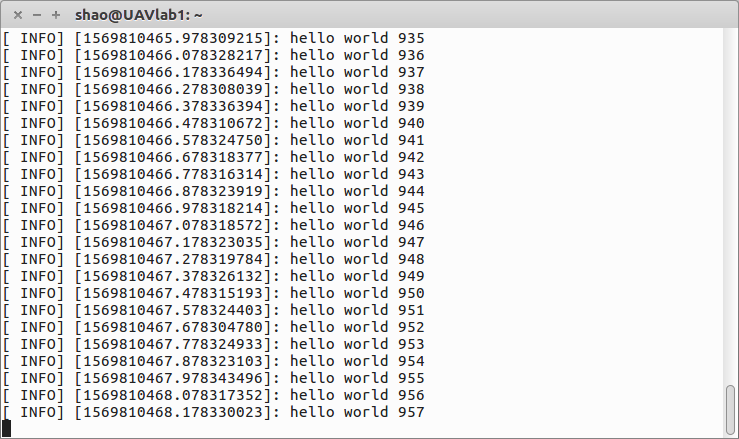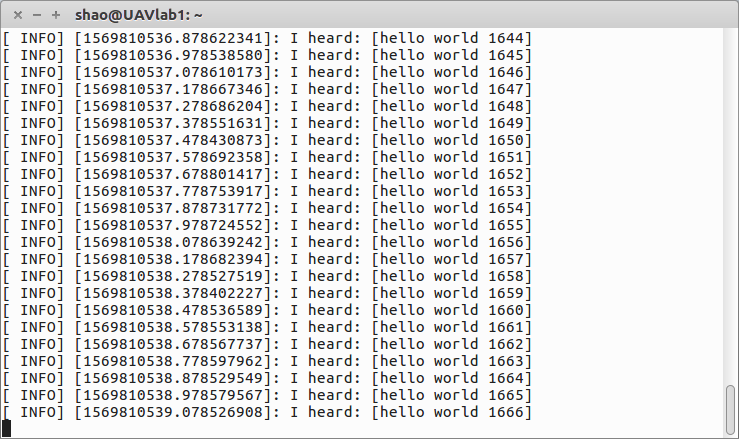ROS学习笔记10-写一个简单的订阅者和发布者(C++版本)
本文档来源于:http://wiki.ros.org/ROS/Tutorials/WritingPublisherSubscriber%28c%2B%2B%29
- 写发布者节点
如前所述,节点是连接到ROS网络的一个可执行程序,在该例中,写一个节点名为Talker,该节点对外不断发布消息。先转到包路径:
roscd begginner_tutorials
先创建一个src目录用于存放源代码:
mkdir -p src
然后在其中创建一个talker.cpp源文件,并将如下内容粘贴其中(代码解读见其中的中文注释)。
/*
* Copyright (C) 2008, Morgan Quigley and Willow Garage, Inc.
*
* Redistribution and use in source and binary forms, with or without
* modification, are permitted provided that the following conditions are met:
* * Redistributions of source code must retain the above copyright notice,
* this list of conditions and the following disclaimer.
* * Redistributions in binary form must reproduce the above copyright
* notice, this list of conditions and the following disclaimer in the
* documentation and/or other materials provided with the distribution.
* * Neither the names of Stanford University or Willow Garage, Inc. nor the names of its
* contributors may be used to endorse or promote products derived from
* this software without specific prior written permission.
*
* THIS SOFTWARE IS PROVIDED BY THE COPYRIGHT HOLDERS AND CONTRIBUTORS "AS IS"
* AND ANY EXPRESS OR IMPLIED WARRANTIES, INCLUDING, BUT NOT LIMITED TO, THE
* IMPLIED WARRANTIES OF MERCHANTABILITY AND FITNESS FOR A PARTICULAR PURPOSE
* ARE DISCLAIMED. IN NO EVENT SHALL THE COPYRIGHT OWNER OR CONTRIBUTORS BE
* LIABLE FOR ANY DIRECT, INDIRECT, INCIDENTAL, SPECIAL, EXEMPLARY, OR
* CONSEQUENTIAL DAMAGES (INCLUDING, BUT NOT LIMITED TO, PROCUREMENT OF
* SUBSTITUTE GOODS OR SERVICES; LOSS OF USE, DATA, OR PROFITS; OR BUSINESS
* INTERRUPTION) HOWEVER CAUSED AND ON ANY THEORY OF LIABILITY, WHETHER IN
* CONTRACT, STRICT LIABILITY, OR TORT (INCLUDING NEGLIGENCE OR OTHERWISE)
* ARISING IN ANY WAY OUT OF THE USE OF THIS SOFTWARE, EVEN IF ADVISED OF THE
* POSSIBILITY OF SUCH DAMAGE.
*/
// %Tag(FULLTEXT)%
// %Tag(ROS_HEADER)%
//Comment by spy: ros/ros.h为ros系统基本功能所需的头文件
#include "ros/ros.h"
// %EndTag(ROS_HEADER)%
// %Tag(MSG_HEADER)%
//Comment by spy: std_msgs/String.h为std_msgs包中的一个消息头文件,由String.msg文件生成
#include "std_msgs/String.h"
// %EndTag(MSG_HEADER)% #include <sstream> /**
* This tutorial demonstrates simple sending of messages over the ROS system.
*/
int main(int argc, char **argv)
{
/**
* The ros::init() function needs to see argc and argv so that it can perform
* any ROS arguments and name remapping that were provided at the command line.
* For programmatic remappings you can use a different version of init() which takes
* remappings directly, but for most command-line programs, passing argc and argv is
* the easiest way to do it. The third argument to init() is the name of the node.
*
* You must call one of the versions of ros::init() before using any other
* part of the ROS system.
*/
// %Tag(INIT)%
// 初始化ROS,这允许我们通过命令行进行重命名,也在该出指定我们的节点名,该命名需要在ROS系统下面唯一的(不能重名)
// 该命名不能含有斜杠(/)。
ros::init(argc, argv, "talker");
// %EndTag(INIT)% /**
* NodeHandle is the main access point to communications with the ROS system.
* The first NodeHandle constructed will fully initialize this node, and the last
* NodeHandle destructed will close down the node.
*/
// %Tag(NODEHANDLE)%
// 创建一个节点句柄,该句柄作为节点进程的句柄,第一次创建时实际上初始化节点,最后一个析构时会释放资源。
ros::NodeHandle n;
// %EndTag(NODEHANDLE)% /**
* The advertise() function is how you tell ROS that you want to
* publish on a given topic name. This invokes a call to the ROS
* master node, which keeps a registry of who is publishing and who
* is subscribing. After this advertise() call is made, the master
* node will notify anyone who is trying to subscribe to this topic name,
* and they will in turn negotiate a peer-to-peer connection with this
* node. advertise() returns a Publisher object which allows you to
* publish messages on that topic through a call to publish(). Once
* all copies of the returned Publisher object are destroyed, the topic
* will be automatically unadvertised.
*
* The second parameter to advertise() is the size of the message queue
* used for publishing messages. If messages are published more quickly
* than we can send them, the number here specifies how many messages to
* buffer up before throwing some away.
*/
// %Tag(PUBLISHER)%
// 该句告诉master主控节点,我们将在chatter主题中发布std_msgs的String消息,在我们发布消息时,
// 主控节点将会告知所有订阅该主题的节点,消息队列大小为1000,即在队列里有消息超过1000个之后,才会丢弃以前老的消息
ros::Publisher chatter_pub = n.advertise<std_msgs::String>("chatter", 1000);
// %EndTag(PUBLISHER)% // %Tag(LOOP_RATE)%
// 指定运行频率为10hz,在调用Rate::sleep()之前都会运行。
ros::Rate loop_rate(10);
// %EndTag(LOOP_RATE)% /**
* A count of how many messages we have sent. This is used to create
* a unique string for each message.
*/
// %Tag(ROS_OK)%
int count = 0;
// 在ros::ok返回true的时候,持续运行,返回false的时候,中断,在以下情况下返回false:
// 1.收到中断信号,SIGINT,键盘输入Ctrl+C会触发中断信号。
// 2.被同名节点从网络上踢出。
// 3.程序的其他部分调用了ros::shutdown()。
// 4.所有的ros::NodeHandles被销毁。
while (ros::ok())
{
// %EndTag(ROS_OK)%
/**
* This is a message object. You stuff it with data, and then publish it.
*/
// %Tag(FILL_MESSAGE)%
// 使用标准消息填充一个字符串。
std_msgs::String msg; std::stringstream ss;
ss << "hello world " << count;
msg.data = ss.str();
// %EndTag(FILL_MESSAGE)% // %Tag(ROSCONSOLE)%
// ROS下的输出语句,代替std::cout标准输出。见ros信息级别小节。
ROS_INFO("%s", msg.data.c_str());
// %EndTag(ROSCONSOLE)% /**
* The publish() function is how you send messages. The parameter
* is the message object. The type of this object must agree with the type
* given as a template parameter to the advertise<>() call, as was done
* in the constructor above.
*/
// %Tag(PUBLISH)%
// 发布消息
chatter_pub.publish(msg);
// %EndTag(PUBLISH)%
// 当添加一个订阅时,ros::spinOnce()会保证,你可以触发回调函数(callback),如果没有该语句,则不会触发。
// %Tag(SPINONCE)%
ros::spinOnce();
// %EndTag(SPINONCE)% // %Tag(RATE_SLEEP)%
// 休眠以确保10hz运行。
loop_rate.sleep();
// %EndTag(RATE_SLEEP)%
++count;
} return 0;
}
// %EndTag(FULLTEXT)%该文件也可以在github如下路径中找到:https://raw.github.com/ros/ros_tutorials/kinetic-devel/roscpp_tutorials/talker/talker.cpp大致步骤如下:
- 初始化ros系统:
ros::init(argc, argv, "talker");
- 创建句柄和发布者:
ros::NodeHandle n;
ros::Publisher chatter_pub = n.advertise<std_msgs::String>("chatter", 1000); 指定频率循环发送。
- 初始化ros系统:
- 编写一个订阅者
同样,在包中创建一个listener.cpp,并粘贴以下代码(代码解释见代码中的中文注释):/*
* Copyright (C) 2008, Morgan Quigley and Willow Garage, Inc.
*
* Redistribution and use in source and binary forms, with or without
* modification, are permitted provided that the following conditions are met:
* * Redistributions of source code must retain the above copyright notice,
* this list of conditions and the following disclaimer.
* * Redistributions in binary form must reproduce the above copyright
* notice, this list of conditions and the following disclaimer in the
* documentation and/or other materials provided with the distribution.
* * Neither the names of Stanford University or Willow Garage, Inc. nor the names of its
* contributors may be used to endorse or promote products derived from
* this software without specific prior written permission.
*
* THIS SOFTWARE IS PROVIDED BY THE COPYRIGHT HOLDERS AND CONTRIBUTORS "AS IS"
* AND ANY EXPRESS OR IMPLIED WARRANTIES, INCLUDING, BUT NOT LIMITED TO, THE
* IMPLIED WARRANTIES OF MERCHANTABILITY AND FITNESS FOR A PARTICULAR PURPOSE
* ARE DISCLAIMED. IN NO EVENT SHALL THE COPYRIGHT OWNER OR CONTRIBUTORS BE
* LIABLE FOR ANY DIRECT, INDIRECT, INCIDENTAL, SPECIAL, EXEMPLARY, OR
* CONSEQUENTIAL DAMAGES (INCLUDING, BUT NOT LIMITED TO, PROCUREMENT OF
* SUBSTITUTE GOODS OR SERVICES; LOSS OF USE, DATA, OR PROFITS; OR BUSINESS
* INTERRUPTION) HOWEVER CAUSED AND ON ANY THEORY OF LIABILITY, WHETHER IN
* CONTRACT, STRICT LIABILITY, OR TORT (INCLUDING NEGLIGENCE OR OTHERWISE)
* ARISING IN ANY WAY OUT OF THE USE OF THIS SOFTWARE, EVEN IF ADVISED OF THE
* POSSIBILITY OF SUCH DAMAGE.
*/ // %Tag(FULLTEXT)%
#include "ros/ros.h"
#include "std_msgs/String.h" /**
* This tutorial demonstrates simple receipt of messages over the ROS system.
*/
// %Tag(CALLBACK)%
// 接收到主题消息时的回调函数
void chatterCallback(const std_msgs::String::ConstPtr& msg)
{
ROS_INFO("I heard: [%s]", msg->data.c_str());
}
// %EndTag(CALLBACK)% int main(int argc, char **argv)
{
/**
* The ros::init() function needs to see argc and argv so that it can perform
* any ROS arguments and name remapping that were provided at the command line.
* For programmatic remappings you can use a different version of init() which takes
* remappings directly, but for most command-line programs, passing argc and argv is
* the easiest way to do it. The third argument to init() is the name of the node.
*
* You must call one of the versions of ros::init() before using any other
* part of the ROS system.
*/
// 初始化:指定节点名称。
ros::init(argc, argv, "listener"); /**
* NodeHandle is the main access point to communications with the ROS system.
* The first NodeHandle constructed will fully initialize this node, and the last
* NodeHandle destructed will close down the node.
*/
// 创建节点句柄
ros::NodeHandle n; /**
* The subscribe() call is how you tell ROS that you want to receive messages
* on a given topic. This invokes a call to the ROS
* master node, which keeps a registry of who is publishing and who
* is subscribing. Messages are passed to a callback function, here
* called chatterCallback. subscribe() returns a Subscriber object that you
* must hold on to until you want to unsubscribe. When all copies of the Subscriber
* object go out of scope, this callback will automatically be unsubscribed from
* this topic.
*
* The second parameter to the subscribe() function is the size of the message
* queue. If messages are arriving faster than they are being processed, this
* is the number of messages that will be buffered up before beginning to throw
* away the oldest ones.
*/
// %Tag(SUBSCRIBER)%
// 订阅指定主题,并指定回调函数,1000为队列大小,当我们来不及处理消息时,会存储在该队列中,若队列元素大于1000,则会抛弃老的消息
ros::Subscriber sub = n.subscribe("chatter", 1000, chatterCallback);
// %EndTag(SUBSCRIBER)% /**
* ros::spin() will enter a loop, pumping callbacks. With this version, all
* callbacks will be called from within this thread (the main one). ros::spin()
* will exit when Ctrl-C is pressed, or the node is shutdown by the master.
*/
// %Tag(SPIN)%
// spin会进入循环,并在有消息到达时处理消息,Ctrl+C会结束该循环,或者主控节点关闭该节点时也会结束循环。
ros::spin();
// %EndTag(SPIN)% return 0;
}
// %EndTag(FULLTEXT)% - 编译节点
在CMakeLists.txt中加入如下代码:add_executable(talker src/talker.cpp)
target_link_libraries(talker ${catkin_LIBRARIES})
add_dependencies(talker beginner_tutorials_generate_messages_cpp) add_executable(listener src/listener.cpp)
target_link_libraries(listener ${catkin_LIBRARIES})
add_dependencies(listener beginner_tutorials_generate_messages_cpp)这些代码会将上述两个节点加入编译为可执行程序,并指定所需链接库和依赖。
然后执行catkin_make,代码如下:# In your catkin workspace
$ cd ~/catkin_ws
$ catkin_make编译成功显示如下:
Base path: /home/shao/catkin_ws
Source space: /home/shao/catkin_ws/src
Build space: /home/shao/catkin_ws/build
Devel space: /home/shao/catkin_ws/devel
Install space: /home/shao/catkin_ws/install
####
#### Running command: "make cmake_check_build_system" in "/home/shao/catkin_ws/build"
####
####
#### Running command: "make -j8 -l8" in "/home/shao/catkin_ws/build"
####
[ 0%] Built target std_msgs_generate_messages_eus
[ 0%] Built target std_msgs_generate_messages_lisp
[ 0%] Built target std_msgs_generate_messages_nodejs
[ 0%] Built target std_msgs_generate_messages_py
[ 0%] Built target std_msgs_generate_messages_cpp
[ 0%] Built target _begginner_tutorials_generate_messages_check_deps_AddTwoInts
[ 0%] Built target _begginner_tutorials_generate_messages_check_deps_Num
[ 5%] Generating EusLisp code from begginner_tutorials/Num.msg
[ 11%] Generating EusLisp manifest code for begginner_tutorials
[ 17%] Generating EusLisp code from begginner_tutorials/AddTwoInts.srv
[ 23%] Generating Javascript code from begginner_tutorials/Num.msg
[ 29%] Generating C++ code from begginner_tutorials/AddTwoInts.srv
[ 35%] Generating C++ code from begginner_tutorials/Num.msg
[ 41%] Generating Python from MSG begginner_tutorials/Num
[ 47%] Generating Lisp code from begginner_tutorials/Num.msg
[ 52%] Generating Javascript code from begginner_tutorials/AddTwoInts.srv
[ 58%] Generating Lisp code from begginner_tutorials/AddTwoInts.srv
[ 64%] Generating Python code from SRV begginner_tutorials/AddTwoInts
[ 64%] Built target begginner_tutorials_generate_messages_nodejs
[ 64%] Built target begginner_tutorials_generate_messages_lisp
[ 70%] Generating Python msg __init__.py for begginner_tutorials
[ 76%] Generating Python srv __init__.py for begginner_tutorials
[ 76%] Built target begginner_tutorials_generate_messages_cpp
[ 88%] Building CXX object begginner_tutorials/CMakeFiles/talker.dir/src/talker.cpp.o
[ 88%] Building CXX object begginner_tutorials/CMakeFiles/listener.dir/src/listener.cpp.o
[ 88%] Built target begginner_tutorials_generate_messages_py
[ 88%] Built target begginner_tutorials_generate_messages_eus
[ 88%] Built target begginner_tutorials_generate_messages
[ 94%] Linking CXX executable /home/shao/catkin_ws/devel/lib/begginner_tutorials/talker
[ 94%] Built target talker
[100%] Linking CXX executable /home/shao/catkin_ws/devel/lib/begginner_tutorials/listener
[100%] Built target listener
- 运行节点
打开一个新终端:roscore
然后运行talker节点:
rosrun beginner_tutorials talker
出现发布信息:

运行listener节点:
rosrun beginner_tutorials listener
出现接收界面:

运行成功。好久不见,hello world。
ROS学习笔记10-写一个简单的订阅者和发布者(C++版本)的更多相关文章
- DuiLib学习笔记2——写一个简单的程序
我们要独立出来自己创建一个项目,在我们自己的项目上加皮肤这才是初衷.我的新建项目名为:duilibTest 在duilib根目录下面有个 Duilib入门文档.doc 我们就按这个教程开始入门 首先新 ...
- DuiLib学习笔记2.写一个简单的程序
我们要独立出来自己创建一个项目,在我们自己的项目上加皮肤这才是初衷.我的新建项目名为:duilibTest 在duilib根目录下面有个 Duilib入门文档.doc 我们就按这个教程开始入门 首先新 ...
- Linux系统学习笔记之 1 一个简单的shell程序
不看笔记,长时间不用自己都忘了,还是得经常看看笔记啊. 一个简单的shell程序 shell结构 1.#!指定执行脚本的shell 2.#注释行 3.命令和控制结构 创建shell程序的步骤 第一步: ...
- laravel学习:php写一个简单的ioc服务管理容器
php写一个简单的ioc服务管理容器 原创: 陈晨 CoderStory 2018-01-14 最近学习laravel框架,了解到laravel核心是一个大容器,这个容器负责几乎所有服务组件的实例化以 ...
- python 学习笔记 12 -- 写一个脚本获取城市天气信息
近期在玩树莓派,前面写过一篇在树莓派上使用1602液晶显示屏,那么可以显示后最重要的就是显示什么的问题了. 最easy想到的就是显示时间啊,CPU利用率啊.IP地址之类的.那么我认为呢,假设可以显示当 ...
- 【opencv学习笔记五】一个简单程序:图像读取与显示
今天我们来学习一个最简单的程序,即从文件读取图像并且创建窗口显示该图像. 目录 [imread]图像读取 [namedWindow]创建window窗口 [imshow]图像显示 [imwrite]图 ...
- UNP学习笔记2——从一个简单的ECHO程序分析TCP客户/服务器之间的通信
1 概述 编写一个简单的ECHO(回复)程序来分析TCP客户和服务器之间的通信流程,要求如下: 客户从标准输入读入一行文本,并发送给服务器 服务器从网络输入读取这个文本,并回复给客户 客户从网络输入读 ...
- Django 学习笔记之六 建立一个简单的博客应用程序
最近在学习django时建立了一个简单的博客应用程序,现在把简单的步骤说一下.本人的用的版本是python 2.7.3和django 1.10.3,Windows10系统 1.首先通过命令建立项目和a ...
- Ruby学习笔记2 : 一个简单的Ruby网站,搭建ruby环境
Ruby on Rails website 的基础是 请求-返回 循环. 首先是浏览器请求服务器, 第二步,Second, in our Rails application, the route ta ...
随机推荐
- 算法复习 : 插入排序原理,记忆,时间复杂度 (7行java实现)
最近啃了一遍吴伟民老师的<数据结构>,记录一些心得. 一种简洁的插入排序 : 1.重要概念 : 哨兵 1.在我们要排序的数组中,哨兵做为一个辅助的位置,一般是0下标的槽位做为哨兵 2.哨兵 ...
- C:C语言中表示进制数
#include <stdio.h> int main() { int a = 123; //十进制方式赋值 int b = 0123; //八进制方式赋值, 以数字0开头 int c = ...
- JavaScript 闭包&基于闭包实现柯里化和bind
闭包: 1 函数内声明了一个函数,并且将这个函数内部的函数返回到全局 2 将这个返回到全局的函数内中的函数存储到全局变量中 3 内部的函数调用了外部函数中的局部变量 闭包简述: 有权访问另一个函数局部 ...
- mqtt开源服务器 EMQX ,客户端MQTTX5.0,使用指南
服务器 EMQX 官网: https://docs.emqx.io/broker/v3/cn/getstarted.html#mqtt-clients 一.安装启动 # 各平台下载https://ww ...
- 在Eclipse或Myeclipse安装Maven插件的几种方法
http://blog.csdn.net/lfsfxy9/article/details/9397937
- Redis数据存储结构之String
前言: 在Redis使用中,我们最常使用的操作是set key value,或 get key value .这里面包含了redis最基本的数据类型:String,字符串类型是redis中最基本的类型 ...
- Codeforces Global Round 5E(构造,思维)
#define HAVE_STRUCT_TIMESPEC#include<bits/stdc++.h>using namespace std;int main(){ ios::sync_w ...
- Centos610无桌面安装Docker-内核升级
1.查看当前操作系统和系统内核 (此处只需要注意一项centos6的docker源只有64位的,x86_64,32位的直接换系统吧) 查看当前内核版本uname -r 2.6.32-754.el6.x ...
- redhat 7.6 iptables 配置
1.查看iptables默认表(filter) iptables -L -n 2.iptables 默认内链(filter)表三种: INPUT:处理进入防火墙的数据包 FORWARD:源自其他计算机 ...
- Redis Set操作
public void CleanPur() { var typedClient = _redisClient.As<PurClass>(); typedClient.DeleteAll( ...
